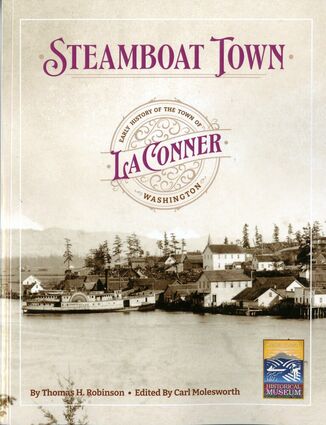La Conner history book launched at museum
December 14, 2022
Few people knew La Conner history as well as the late Thomas Robinson. Thanks to his exhaustive research and the editing magic of Carl Molesworth, the town's early development is between a book's covers.
Robinson's voluminous manuscript, "Steamboat Town," which Molesworth, John Kamb, Jr. and other members of the Skagit County Historical Society's publications committee have pored over for about a decade, was launched in book form last Thursday.
Kamb moderated the informal evening program at the Skagit County Historical Museum, where copies of the book are available for purchase.
He shared highlights of Robinson's life and career. Robinson's parents farmed near the intersection of Avon-Allen and McLean roads and befriended his family.
He recalled, "My great-aunt Margaret grew up with Tom and I always looked at him as 'Uncle' Tom even though they weren't married."

Kamb said Robinson was "very intellectual" and would go on to serve in the U.S. Foreign Service and as a professor at the University of Maryland.
But La Conner and Skagit County remained much on Robinson's mind.
He chose La Conner as his retirement home, taking up residence in a condo unit near Sacred Heart Catholic Church and started work on "Steamboat Town" between teaching gigs at Skagit Valley College.
He emphasized the early stage of La Conner's settlement, a time when commercial water transportation on Swinomish Channel was king.
"I read through the original draft," said publications committee chair Dan Berentson, "and what I thought was a powerful part of the book is how it follows the money during the industrial age. The steam engine, railroads and transportation in general were taking off. I thought it was a realistic take on what was happening in La Conner. The initial speculators here were keen on maritime transportation. In the meantime, the railroad got to Mount Vernon."
In "Steamboat Town," Robinson also chronicles in the detailed style of novelist James Michener landforms and geological features in and around La Conner, including an explanation why the current in Swinomish Channel flows primarily from south to north.
It references early downtown businesses and some of the characters who frequented the waterfront during La Conner's formative years.
Kamb said the "Steamboat Town" manuscript ran about 1,000 pages. Upon his death, Robinson bequeathed the lengthy, unedited version of the book to the museum on condition that it be published, said Kamb, retained as personal representative of the author's estate.
"We thought the material was edited and concise," Kamb related. "It wasn't."
Enter Molesworth, an author and retired newspaper editor. He was tasked with transforming the manuscript into a leaner volume more user friendly for a general readership.
"Carl did a great job," Kamb said.
"It was a very academic work," added former Skagit County Pioneer Association President Dan Royal. "I feel terrible that Tom died before he could see it printed. He was a really good guy and left us a great legacy with this book. People are always asking about the history of La Conner's early days."
Berentson said a strength of "Steamboat Town" is that it presents a realistic rather than nostalgic perspective of historic La Conner.
That doesn't surprise Kathy Brosnan, a student of Robinson's at SVC. His command of facts was unrivaled, she said.
"You could ask him anything," said Brosnan, "and he would talk and talk. The information that he had was amazing."
And what Robinson knew of La Conner he has shared in perpetuity.
Kamb, for one, plans getting the word out ASAP via his holiday shopping list.
"It's really good stuff," he said of the book, "and will make a perfect Christmas gift."




Reader Comments(0)